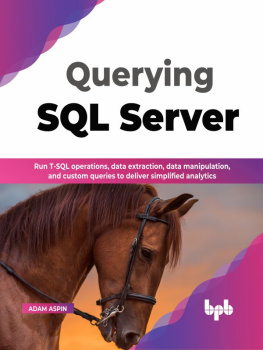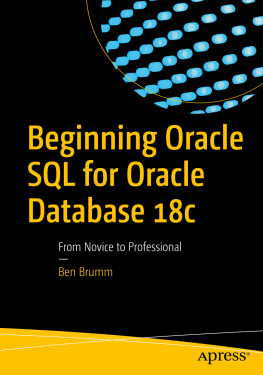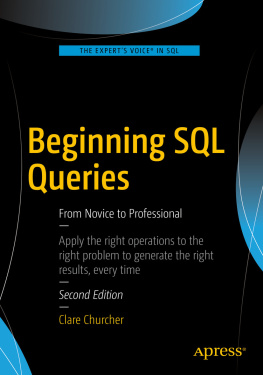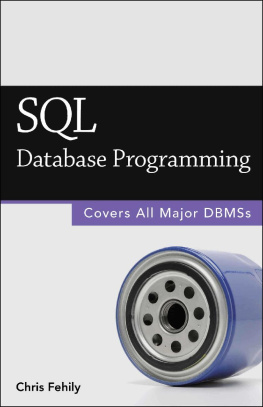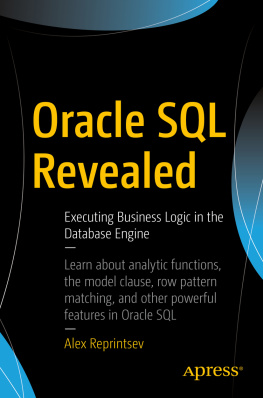This text provides some interestingexamples of using SQL when it comes to querying database data. The level ofcomplexity implies youre not a total beginner to SQL and have at least a basicunderstanding of how SQL queries are built. To understand and follow thesamples though, you are not supposed to be an advanced SQL user either eachexample comes with a detailed explanation of how it works, illustrating thateven complex data management tasks can be taken easy with the proper use of SQLcapabilities.
The sample queries provided in this text areimplemented with Oracle SQL and MySQL SQL dialects, meaning youll need to haveaccess either to Oracle Database or to MySQL to follow them. With someadjustments, the samples can be used in other systems, of course. In otherwords, the sample queries youll see here are not specific to a certaindatabase platform, focusing on some interesting data management tasks, ratherthan system specific ones.
Using Non-Equi Joins
In most cases, a join is a query on two tablesconnected through two columns each from a different table with the help ofthe equality operator. In the case of a non-equi join however, that would bemost likely wrong to the first statement, wrong to the second, and wrong to thethird. The point is, non-equi joins are those ones in which the join conditionrelies on an inequality comparison performed within the same column, and areoften defined on the same table, thus representing self joins.
In the following example, you build a non-equi-joinover a table whose rows contain information about three football teams. Thestructure of the team table used in this example is very straightforward andconsists just of two columns: team_no and team_name. You are supposed toprepare a schedule for a series of games so that each team meets the othersonce. As you might guess, using an equi-join is not an option here, because youwould end up with each team scheduled to play against itself just like in thefollowing example, assuming you have the team table already created and filledwith the data: SELECT t1.team_name team1, t2.team_name team2 FROM team t1, team t2 WHERE t1.team_no = t2.team_no TEAM1 TEAM2 ---------------------------------- IceMen IceMen Slavia Slavia Amazzo Amazzo Of course, thats not what you want to see. Incontrast, using an inequality comparison brings the desired results. All youneed to do is to replace t1.team_no = t2.team_nowith t1.team_no < t2.team_no in theabove query to get the results you need, which might look like this: TEAM1 TEAM2 ---------------------------------- IceMen Slavia IceMen Amazzo Slavia Amazzo Although, this time you have the right combination,thats not it, though.
Suppose you also have to set a date for each game. Beingan Oracle database user, you can do that with the SYSDATE function along withthe ROWNUM function. So, if you need to establish the first match in a week andthen each next day, then the query might look like this: SELECT t1.team_name team1, t2.team_name team2,SYSDATE + ROWNUM + 6 GAME_DATE FROM team t1, team t2 WHERE t1.team_no < t2.team_no Producing the following output: TEAM1 TEAM2 GAME_DATE ------------------------------------------------------------ IceMen Slavia 17-AUG-15 IceMen Amazzo 18-AUG-15 Slavia Amazzo 19-AUG-15 If you are using MySQL, the query might look likethis to produce the same output: SELECT t1.team_name team1, t2.team_name team2,INTERVAL (@rownum:=@rownum+1) + 6 DAY + CURDATE() GAME_DATE FROM team t1, team t2, (SELECT @rownum:=0) r WHERE t1.team_no < t2.team_no;
Reporting on Sparse Datetime Data
Alternatively, this section might be titled:Fabricating Data Sets, because thats exactly what you often have to do when itcomes to reporting on sparse data: densify a sparse data set by fabricating themissing values. In the case of date data, such missing values can be generatedon the fly, within a query. For example, you may need to generate a row perhour within a certain day or generate a row per day within a certain daterange. Often you need a report showing every date/time position within theentire range, regardless of whether there was an activity on a particular dayor hour, or not.
Consider the following example. Suppose you want togenerate an order total report for the following date diapason: 01-jan-15 to15-jan-15, which would include a row for each day within the specifieddiapason, whether there were orders on a given day or not. In other words, youneed to build a query that will output a row for each day of those fifteen inthe diapason. The only guaranteed way to achieve this is with the help of ajoin connecting the selection from the orders table to the desired date rangeset, which might be either generated on the fly or selected from a table. Whenusing Oracle Database, you can choose between these two options. In MySQL, youhave only the latter option.
Lets start with an example for Oracle Database. Tokeep things simple, first lets look at the query generating the required dateset. Such a query might look like this: SELECT rownum num, TO_DATE('01-jan-15', 'dd-mon-yy') + INTERVAL '1' DAY*rownum-1 date_ FROM dual CONNECT BY LEVEL <= 15; The output produced should look like this: NUM DATE_ ---------- --------- 101-JAN-15 202-JAN-15 303-JAN-15 404-JAN-15 505-JAN-15 606-JAN-15 707-JAN-15 808-JAN-15 909-JAN-15 1010-JAN-15 1111-JAN-15 1212-JAN-15 1313-JAN-15 1414-JAN-15 1515-JAN-15 15 rows selected. Alternatively, you might calculate the number ofdays to be included in the report in the CONNECT BY LEVEL clause, as follows: SELECT rownum num, TO_DATE('1-jan-15','dd-mon-yy') + (rownum - 1) date_ FROM dual CONNECT BY LEVEL <= TO_DATE('15-jan-15','dd-mon-yy') - TO_DATE('1-jan-15', 'dd-mon-yy') +1; This should result in the same output as thepreceding one. Its fairly obvious that the query discussed here can be part ofa bigger one, showing information on some activities per day within thespecified diapason. In other words, you can build a join in which the abovewill generate a virtual table of 15 rows containing the dates from thediapason, and the other query in the join will walk through a table, such asorders, retrieving those placed within the range.
For simplicity, suppose you have an orders tablecontaining some generalized information about purchase orders. Such a tablemight be created as follows: CREATE TABLE orders( referenceVARCHAR2(32), ord_dateDATE, totalNUMBER(12,2) ); Then, you can fill it with the data: INSERT INTO orders VALUES( JCHEN-20150107123336462PDT, TO_DATE(7-jan-2015,DD-MON-YYYY), ); Of course, you might have more rows inserted. Now you can issue a join that might look like this: SELECT date_, nvl(Total,0) Total FROM (SELECTTO_DATE('01-jan-2015','dd-mon-yyyy')+INTERVAL '1' DAY*rownum-1 date_ FROM dual CONNECTBY LEVEL <=15) LEFTOUTER JOIN (SELECTsum(o.Total) Total, o.ord_date date_ FROM orders o GROUP BYo.ord_date) USING(date_) ORDER BYdate_; The output should look like this: DATE_ TOTAL --------- ---------- 01-JAN-15 0 02-JAN-15 0 03-JAN-15 0 04-JAN-15 0 05-JAN-15 0 06-JAN-15 0 07-JAN-15 121 08-JAN-15 0 09-JAN-15 0 10-JAN-15 0 11-JAN-15 0 12-JAN-15 0 13-JAN-15 0 14-JAN-15 0 15-JAN-15 0 15 rows selected. Looking through the above report, you may noticethat although the only day has an order, the report shows all the days in thespecified diapason. In MySQL, there is no CONNECT BY LEVEL feature, nor anyequivalent. So, you cannot generate rows on the fly in the way you can do it inOracle Database.



